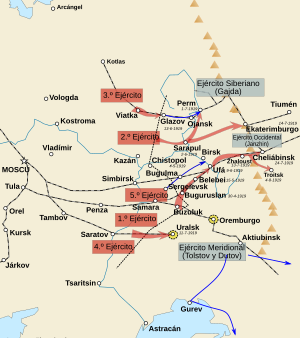| Counteroffensive of Eastern Front | |||||||
|---|---|---|---|---|---|---|---|
| Part of the Russian Civil War | |||||||
 Counteroffensive of Eastern Front | |||||||
| |||||||
| Belligerents | |||||||
|
|
| ||||||
| Commanders and leaders | |||||||
|
|
| ||||||
| |||||
The Counteroffensive of Eastern Front (April–July 1919) was an episode of the Russian Civil War.
Background[]
In 1917, The Russian Communist Party staged a revolution against Tsar Nicholas II's Russian government that led to a civil war. During the spring of 1919 the Kolchak army offensive created a strategic breakthrough in the center of The Red Army's Eastern Font, while the Reds were preparing their own offensive on the southern flank.
Idea[]
At the time of the White Army offensive, the Reds had a big force on the southern flank. The White army was dispersed in several groups and the Reds attempted to crush those groups from south to north one by one. Reserves were used to rebuild the Red's 5th Army and delay the Whites' advancement in the center of the front.
Battles[]
At the southern flank the Whites tried to capture Orenburg without success. General Belov decided to use his reserve – IV corps – to outflank Orenburg from the north. Red commander Gaya Gai regrouped and crushed the Whites during a 3-day battle from 22–25 April and the remains of the White forces changed sides. As a result, there was no cover for the White Western Army's rear communications (commander – Mikhail Hanzhin). On April, 25, Supreme Command of the Reds' Eastern Front ordered an advance.
On April, 28, the Reds crushed two divisions of the Whites in the region to the south-east of Buguruslan. While suppressing the flank of advancing the Whites' armies, the Reds' command ordered the advancing Southern Group to the North-West. On May, 4, the Red 5th Army captured Buguruslan, and the Whites had to quickly retreat to Bugulma. On May, 6, Mikhail Frunze (commander of Red's Southern Group) attempted to surround the White Forces, but the Whites quickly retreated to the east. At May, 13, the Red 5th Army captured Bugulma without fighting.
Aleksandr Samoilo (new commander of Red's Eastern Front) took the 5th Army from the Southern Group and ordered a strike on the Northeast in retribution for their assistance to the Northern Group. The Southern Group was reinforced by two rifle divisions. The outflanked Whites had to retreat from Belebey to the east, but Samoilo didn't realize that the Whites were defeated and ordered troops to stop. Frunze didn't agree and on May 19, Samoilo ordered troops to pursue the enemy.
The Whites concentrated six infantry regiments near Ufa and decided to outflank the Reds' Turkestan Army. On May, 28, the Whites crossed the Belaya River, but were crushed on May 29. On May 30, the Red 5th Army crossed the Belaya River and captured Birsk on June 7. Also on June 7 the Reds Southern Group crossed the Belaya River and captured Ufa on June 9. On June 16 the Whites began a general retreat in the eastern direction on the whole front.
Aftermath[]
The Crushing of the Whites in the Middle and South prepared for the Reds' crossing of the Ural mountains. Advancement of the Reds forced the Whites' north group to retreat, because Red armies were able to cut its communications.
Sources[]
- Н.Е.Какурин, И.И.Вацетис "Гражданская война. 1918–1921" (N.E.Kakurin, I.I.Vacietis "Civil War. 1918–1921") – Sankt-Peterburg, "Polygon" Publishing House, 2002. ISBN 5-89173-150-9
The original article can be found at Counteroffensive of Eastern Front and the edit history here.